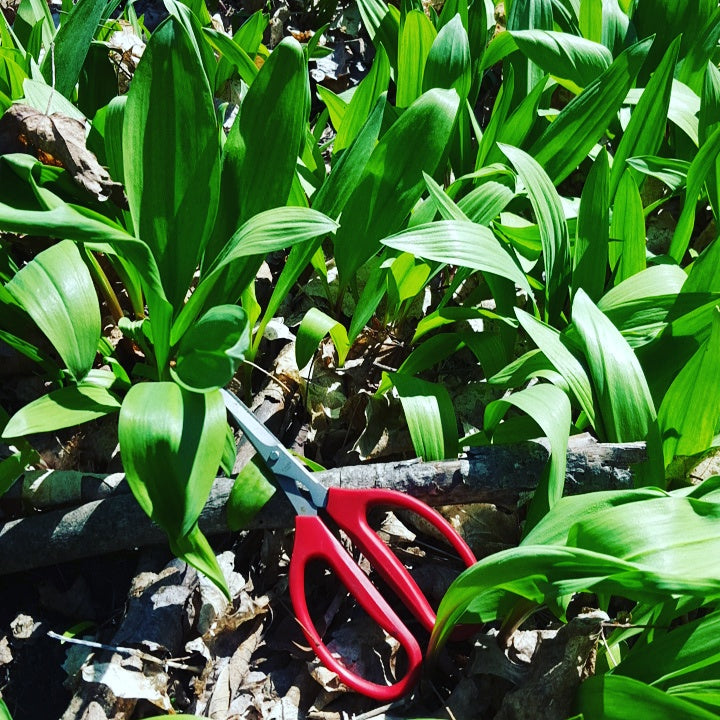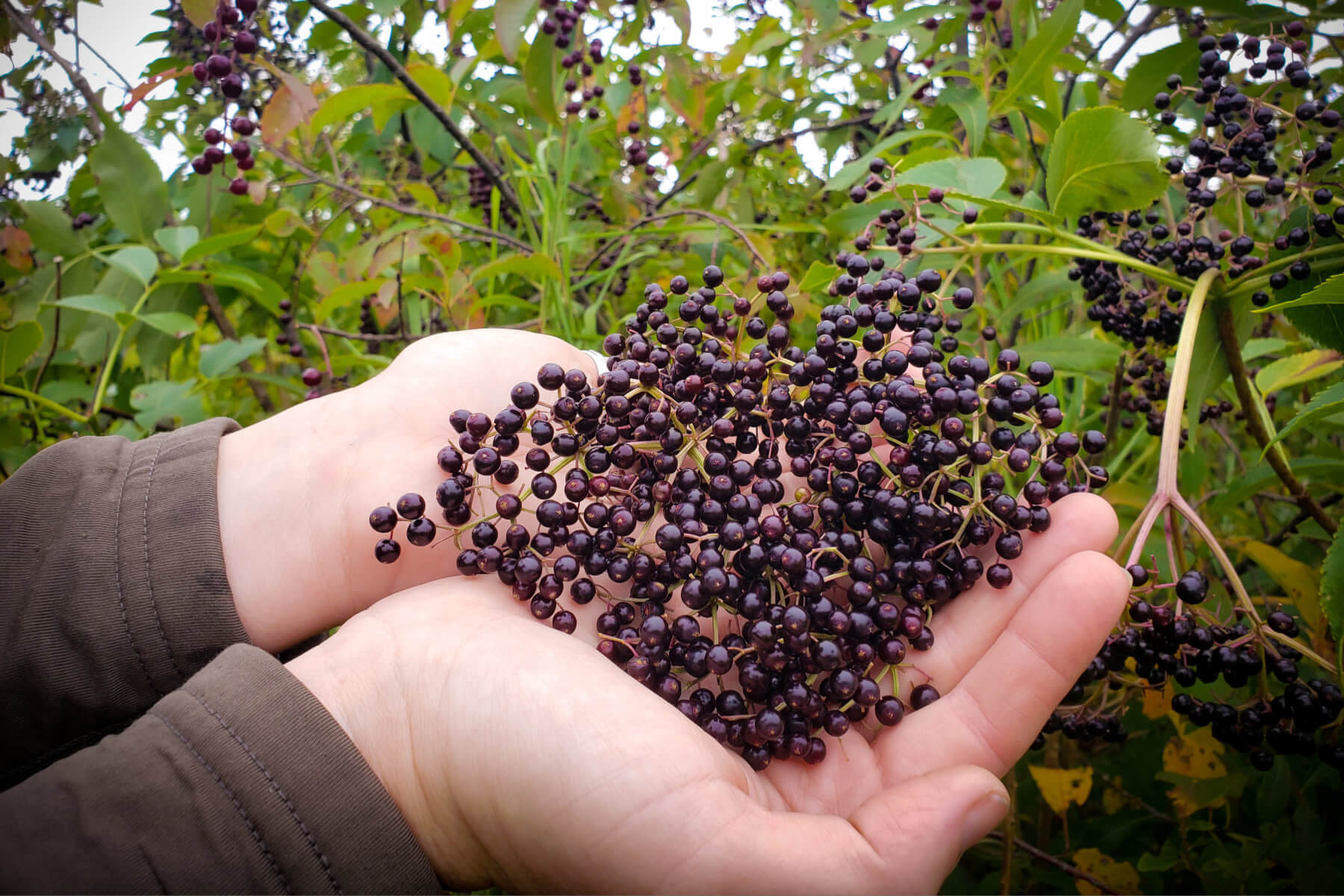Wild Leeks (AKA Wild Ramps) are one of the earliest spring edibles you can wild forage for. They are delicious and can be used in many different recipes.
However, it is essential to learn to harvest wild leeks sustainably, as they have been overharvested and are close to extinction in parts of their range.
In this post, we will share everything you need to know about:
- How to Identify Wild Leeks (AKA Ramps),
- Where to Find & Harvest Wild Ramps Sustainably,
- How to Cook Wild Leeks,
- The Best Wild Leek Recipes,
- Where to Buy Wild Leeks (and Products),
----------------------------------------------------------------------------
1. What are Wild Leeks & Wild Ramps?
Wild Leeks (Allium tricoccum) are members of the Allium Genus, including onions, garlic and leeks. Consider them the wild and usually a more flavourful version of the leeks you buy in the grocery store.
They are known as spring ephemeral, meaning they leaf for only a few weeks in the spring before the forest canopy develops. Then, the leaves die back, not to be seen again until spring.
They are highly sought-after spring edibles for foragers and outdoor lovers.
Are Ramps and Wild Garlic the same as Wild Leeks?
You may hear the terms Wild Leeks, Ramps or Wild Garlic. These three regional-specific terms are what we call "common names." They all refer to the same plant species, which has the Latin name Allium tricoccum.
Are Wild Leeks safe to eat?
Although they are not related to the commonly cultivated leeks in the grocery store, they are an excellent wild edible. Just make sure you identify them correctly.
Both the leaves and the bulbs have a delicious onion and garlicky taste.
They can be a little harsh on the stomach if eaten raw (just like eating a raw garlic clove), so we suggest cooking them before consumption (see recipes below).

What are Wild Leeks good for?
First off, we must recognize that Wild Leeks play a vital role in the ecology of the forests in which they grow. They help build soil by laying down their leaves each spring, stabilize slopes from erosion with their roots, and feed insects and wildlife such as Deer and Wild Turkeys.
Wild Leeks also make a fantastic edible to add flavours to many different dishes. Here is a list of just a few of the things we make with wild leeks (see recipes at the bottom):
- Wild Leek & Potato Soup
- Pickled Ramps
- Deviled Eggs
- Pastries
- Infused Wild Leek Vinegar (for salad dressings, steamed veggies & stir fry's)
- Wild Leek Infused Salt (great for meat rubs, eggs, corn on the cob, popcorn, really anywhere you use sale)
How do Wild Leeks grow?
Wild Leeks are a slow-growing perennial plant in the onion family, native to the hardwood forests of Northeastern North America.
Leeks are an ephemeral species similar to Trilliums. They grow, flower, and set seeds in a few short weeks in early spring.
They emerge to take advantage of the short period of full sun the forest floor receives after the snow has melted but before the trees leaf out. Once the forest canopy leaves out, the leek leaves die back, and the bulbs stay hidden underground until they emerge again the following spring.
2. How to Identify Wild Leeks & When to Harvest Them?
It is essential to identify wild leeks correctly if you are looking to harvest them. There are a handful of other species a novice forager may confuse them with, some of which have toxic properties.
You can also watch are two-part YouTube Series on how to identify and sustainably harvest Wild Leeks ~ Watch Here ~
Where and what months do you Harvest Wild Leeks?
- Where to Find Wild Leeks? Ramps grow on the forest floor under deciduous trees such as maple. They are often located on south-facing slopes but can also be found in flat areas.
- When to Harvest Ramps? - Wild Leeks are ephemeral plants (see the definition above). This means they leaf out in the spring, usually mid-May. If the forest canopy has already fully leafed out and you are finding leaves, double-check your identification as they may NOT be wild leeks.
What do Wild Leeks look like when are they ready to harvest?
- They grow in clumps, often 4 - 8 inches (10 - 20cm) thick, with the bulbs growing quite close together. These clusters can span large tracts of the forest in suitable habitats, assuming they have not been over-harvested by unsustainable foraging techniques (we will discuss this further below).
- Depending on the age of the plant, there will be 1 to 3 flat lance-shaped green leaves, approximately 3 - 10 inches (7.5 - 20 cm) long.
- The leaves of an individual leek plant grow in a basal arrangement, meaning they all originate from the same base in a cluster.
- The small white bulbs are buried under the soil.
- If you rub any part of the plant between your fingers and smell them, there should be a distinct onion smell.
- The leaves are papery and translucent when light shines through them.
- The leaves narrow near the stems and often change from vibrant green leaf colour to maroon along the stem.

Do Ramps have a look alike? What else looks like Wild Leeks?
A similar-looking plant, Lily-of-the-valley (Convallaria majalis), is a highly toxic common garden plant that can easily be mistaken for Wild Leeks. However, the leaves of Lily-of-the-valley swirl, the leaves are thick and not transparent, and the plant does not have the characteristic odour of Wild Leeks.
A novice forager may also confuse ramps with Blue Bead Lily (Clintonia borealis).

(Image of ramps look alike, Lily-of-the-valley)
What does the Wild Leek flower look like?
Seeing a Wild Leek flower feels like a bit of a rare gift as they flower after the leaves have wilted and often withered away. It is more likely to come across the purple seed heads when harvesting.
If you go back to check on a wild ramp patch after its leaves are gone in the early summer, you may get the opportunity to see the beautiful wild leek flowers.
They have three white petals and three white sepals arranged in an umbel formation. Only a small number of the older ( seven years plus) wild leeks will flower each season.

3. How to Sustainably Harvest Wild Leeks
Due to their popularity as wild food, ramps have been over-harvested to near extinction in many areas. In some regions, it is now illegal to harvest Ramps. Fortunately, we still have areas with large populations of wild leeks in Ontario.
Sustainable Wild Leeks Harvesting Tips:
- Remember, ramps take 7-15 years to mature and multiply. Patches that are over-harvested can take many, many years to recover.
- Wild Leeks are very strong in flavour. A little goes a long way in recipes, and remember, you cannot substitute Wild Leeks for traditional Leeks. Take only what you need, and use what you take.
- The most sustainable way to harvest Wild Leeks is to pick one leaf from each plant. The leaves contain the same flavour as the bulb without killing the plant. This allows the bulb and root to remain intact and allows the plant to flower, set seed, and not disturb the soil.

4. Another option is to carefully cut the bulb approximately a half centimetre above the roots. Leave the bottom centimetre with the roots in the ground and take the rest. This often does not kill the plant.
If you are choosing to harvest the entire plant, we encourage you to follow the following guidelines;
- Harvest on private land where you know there is limited or no other harvesting pressure from wild foragers.
- Select patches larger than two meters in size and in forests with an abundance of Wild Leeks.
- Never take more than 5% of the patch and harvest from a different patch the following year.
- Use the whole plant. The leaves, bulb, and even the roots can be used in recipes. If you harvest it, use it!
How to dig and harvest Ramp bulbs:
- Using a shovel to dig out a small section of dense growing Leeks.
- Carefully knock the soil from the roots back into the hole they came from. This soil contains dormant seeds.
- Separate the small immature leeks from the large ones you are harvesting.
- Replant the small ones back into the hole, or use them to propagate a new patch elsewhere.
Where can you harvest Wild Leeks?
We suggest harvesting on private property whenever possible. This ensures you (or the property owner) are aware of how much is being harvested each season and thus makes it easier to manage the patch sustainably.

It is often hard to know how many other people harvest from the same patch when harvesting on public land. If everyone takes 5%, the patch can suffer badly and may never recover.
When harvesting on private land, you need to have the owner's permission; otherwise, it is considered trespassing, and charges could apply.
Many people harvest wild leeks in Ontario along roadsides. We discourage this for several reasons. It’s dangerous to have stopped cars along our windy cottage roads, there is likely residue from winter road salt in the soil, making the plants not healthy to harvest, and you are likely on private land, which without permission is trespassing.
Conservation areas, municipal, provincial and national parks all have their own rules for harvesting plants that you must be aware of. We recommend not harvesting in high-use public recreation areas for sensitive species like Wild Leeks as many other people may also be picking from these patches. If you do pick, please pick leaves only.
How to Grow and Transplant Wild Leeks & Start Your Own Forest Garden!
If you don’t have your own patch of Wild Leeks to harvest, you can plant your own. They grow happily in the rich and moist, shaded soil under hardwood (deciduous) trees.
Although they may be slow to grow, they transplant very well and have a high success rate from seed (the seed will lay dormant for 2 years before sprouting).
Patches may be started by planting the small immature Leeks from your harvest or, even better, transplanted from properties that are going to be developed.
Ensure the roots of the Leeks are planted into the mineral soil under the soft layer of leaves.
The best way to get your hands on plants or seeds is to support local native plant nurseries. They are also very knowledgeable and are happy to help you make sure you are selecting the right location for your Leeks.
Here is a selection of native plant nurseries that carry Wild Leek plants and/or seed in Ontario.
- Claremont Native Plants (http://www.nativeplants.ca)
- Grow Wild (http://nativeplantnursery.ca/)
- Williams Nursery (http://stwilliamsnursery.com/)
5. Where to Buy Wild Leeks that are Sustainably Harvested
As the popularity of wild foods and foraging grows, it is becoming more popular to see Wild Leeks at grocery stores, farmers' markets and online.
Before purchasing Ramps, we encourage you to ask the supplier the following questions:
- Where were these wild leeks foraged?
- What practices do you use to ensure they are being harvested sustainably?
Below is a list of some reputable suppliers you can buy Wild Leeks and Ramp
products from and feel good you are supporting sustainable wild foraging:
- Wild Muskoka Botanicals. Us, of course! If you have not tried our Wild Leek Vinegar or Wild Salt (which also contains Spruce tips & Sweet Gale catkins), you really are missing out on something special ;)
- Forbes Wild Foods sells a large variety of wildcrafted foods. Check out their Pickled Wild Leeks
- If you are located in the USA. Check out Foraged.Market. They sell an array of wild foraged foods and also carry our Wild Salt & Wild Leek Vinegar.
6. The Best Wild Leek & Ramp Recipes of 2023
There are many different recipes and ways to prepare Wild Leeks. We discuss a few our favorites below and share recipes and ways to preserve wild leeks.
Here is a fun video we made of a Sugar-free Wild Leek Coleslaw. Watch Here
Salad Dressing
Wild Leek Salt & Vinegar Kale Chips
The recipe involves using dried Wild Leeks mixed with fine grain finishing salt and wild leek infused vinegar (see "ways to preserve wild leeks" below). You can also use our Wild Muskoka Wild Salt & Wild Leek Vinegar.
Ingredients:
- 1 large bunch of kale
- 2 tbls Wild Leek infused vinegar
- 1 tbls Olive Oil
- 1/2 tsp of Wild Salt
Preparation:
Preheat oven to 350 degrees F.
- Wash and dry kale leaves. Using a knife, separate the green kale leaves from the thick ribs, and discard the ribs. Cut or tear the kale leaves into your desired size of chips, knowing that they will shrink a bit while baking.
- Combine the kale leaves, vinegar, oil and 1/4 teaspoon of salt in a large bowl. Then use your hands to toss and massage the kale for 1-2 minutes until it is soft and slightly darker.
- Spread out the kale in a single layer on a parchment-covered baking sheet (or two). Then sprinkle on the remaining salt. Bake for 7-10 minutes, or until the kale is crunchy and no longer soft. Remove and serve immediately, or store in a sealed container for up to 1 week.
Wild Leek Tangy Garden Cucumber Salad
The recipe also involves using dried Wild Leeks mixed with fine grain finishing salt and wild leek infused vinegar (see "ways to preserve wild leeks" below). You can also use our Wild Muskoka Wild Salt & Wild Leek Vinegar.
Ingredients:
- 1/4 cup wild leek vinegar
- 2 tablespoons olive oil
- 1 teaspoon wild salt
- Black pepper
- 2 pounds cucumbers (about 4 medium)
- 2 tablespoons finely chopped parsley
Preparation:
Place the Wild Leek vinegar, oil, salt, and a few grinds of pepper in a large bowl and whisk to combine.
Slice the cucumbers into thin 1/8-inch-thick rounds. Place them in the bowl, add the parsley, and toss to combine. Cover and refrigerate for at least 30 minutes or overnight to allow the flavours to meld.
Wild Leek Soup and Wild Leek Pesto
Click the links below to try some of our favorite wild leek recipes that others have shared:
- Potato & Wild Leek (Ramp) Soup Recipe by Spruce Eats
- Wild Ramp Pesto Recipe by Adamant Kitchen
7) How to Preserve Wild Leeks
Can you preserve Wild Leeks?
Yes, there are several ways to preserve your harvest. Wild Leeks have a very short harvest window in the spring; thus, learning to preserve ramps is a great skill to allow you to savour their wonderful taste throughout the year.
The four main ways to preserve Wild Leeks are to:
- Dry Your Wild Ramps - We use a food dehydrator to dry the leaves. Then we sprinkle them like a spice into baking, on salads and into soups.
- Make Wild Leek Salt - This adds so much flavour to your salt and can be used on almost anything you already put salt on, from corn on the cob to meat rubs to your morning eggs. Once our Wild Leeks are dry, we mix them with salt and other herbs. Want to try? You can buy our Wild Salt here!
- Infuse Wild Leek into Vinegar - We also infuse the fresh leaves into organic apple cider vinegar. We do this inside mason jars and let it steep for a month or more. Afterwards, we strain it and bottle it. Then we use the infused wild ramp vinegar in salad dressings, drizzled on steamed vegetables or in stir frys.
- Pickle Your Ramps - Many people will pickle the bulbs in brine, and then pressure can them.
8. Closing thoughts on Safety when Foraging

Foraging is a wonderful way to connect with nature. It is very satisfying to wild harvest your food from the forest, but you need to be cautious.
Although most plants in the forests of Muskoka and Ontario are non-toxic, there are a few that are deadly poisonous and many that are toxic. Many plants also have poisonous look-alikes.
If you are new to foraging for wild edibles, a great starting point is to learn about "The 5 Rights of Wild Crafting."
You should never consume a wild plant or mushroom that you are not 100% certain of the identification. Use caution and multiple credible resources for identification.
Recommended Field Guides for Plant Identification
Here are a few field guides we suggest to help increase your plant identification skills:
- Lone Pine: Edible & Medicinal Plants of Canada
- Lone Pine; Plants of Southern Ontario
- Lone Pine; Mushrooms of Eastern Canada




